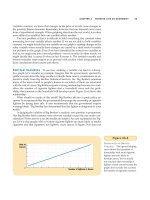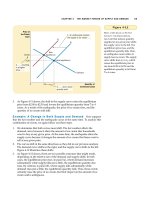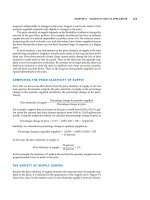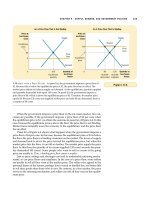Tài liệu Ten Principles of Economics - Part 7 pptx
Bạn đang xem bản rút gọn của tài liệu. Xem và tải ngay bản đầy đủ của tài liệu tại đây (279.91 KB, 10 trang )
IN THIS CHAPTER
YOU WILL . . .
Consider the key
role of prices in
allocating scarce
resources in market
economies
Examine what
determines the
supply of a good in a
competitive market
Learn the nature of
a competitive
market
Examine what
determines the
demand for a good
in a competitive
market
See how supply and
demand together set
the price of a good
and the quantity
sold
When a cold snap hits Florida, the price of orange juice rises in supermarkets
throughout the country. When the weather turns warm in New England every
summer, the price of hotel rooms in the Caribbean plummets. When a war breaks
out in the Middle East, the price of gasoline in the United States rises, and the price
of a used Cadillac falls. What do these events have in common? They all show the
workings of supply and demand.
Supply and demand are the two words that economists use most often—and for
good reason. Supply and demand are the forces that make market economies
work. They determine the quantity of each good produced and the price at which
it is sold. If you want to know how any event or policy will affect the economy,
you must think first about how it will affect supply and demand.
This chapter introduces the theory of supply and demand. It considers how
buyers and sellers behave and how they interact with one another. It shows how
THE MARKET FORCES OF
SUPPLY AND DEMAND
65
66 PART TWO SUPPLY AND DEMAND I: HOW MARKETS WORK
supply and demand determine prices in a market economy and how prices, in
turn, allocate the economy’s scarce resources.
MARKETS AND COMPETITION
The terms supply and demand refer to the behavior of people as they interact with
one another in markets. A market is a group of buyers and sellers of a particular
good or service. The buyers as a group determine the demand for the product, and
the sellers as a group determine the supply of the product. Before discussing how
buyers and sellers behave, let’s first consider more fully what we mean by a “mar-
ket” and the various types of markets we observe in the economy.
COMPETITIVE MARKETS
Markets take many forms. Sometimes markets are highly organized, such as the
markets for many agricultural commodities. In these markets, buyers and sellers
meet at a specific time and place, where an auctioneer helps set prices and arrange
sales.
More often, markets are less organized. For example, consider the market for
ice cream in a particular town. Buyers of ice cream do not meet together at any one
time. The sellers of ice cream are in different locations and offer somewhat differ-
ent products. There is no auctioneer calling out the price of ice cream. Each seller
posts a price for an ice-cream cone, and each buyer decides how much ice cream to
buy at each store.
Even though it is not organized, the group of ice-cream buyers and ice-cream
sellers forms a market. Each buyer knows that there are several sellers from which
to choose, and each seller is aware that his product is similar to that offered by
other sellers. The price of ice cream and the quantity of ice cream sold are not de-
termined by any single buyer or seller. Rather, price and quantity are determined
by all buyers and sellers as they interact in the marketplace.
The market for ice cream, like most markets in the economy, is highly compet-
itive. A competitive market is a market in which there are many buyers and many
sellers so that each has a negligible impact on the market price. Each seller of ice
cream has limited control over the price because other sellers are offering similar
products. A seller has little reason to charge less than the going price, and if he or
she charges more, buyers will make their purchases elsewhere. Similarly, no single
buyer of ice cream can influence the price of ice cream because each buyer pur-
chases only a small amount.
In this chapter we examine how buyers and sellers interact in competitive
markets. We see how the forces of supply and demand determine both the quan-
tity of the good sold and its price.
COMPETITION: PERFECT AND OTHERWISE
We assume in this chapter that markets are perfectly competitive. Perfectly competi-
tive markets are defined by two primary characteristics: (1) the goods being of-
fered for sale are all the same, and (2) the buyers and sellers are so numerous that
market
a group of buyers and sellers of a
particular good or service
competitive market
a market in which there are many
buyers and many sellers so that each
has a negligible impact on the market
price
CHAPTER 4 THE MARKET FORCES OF SUPPLY AND DEMAND 67
no single buyer or seller can influence the market price. Because buyers and sell-
ers in perfectly competitive markets must accept the price the market determines,
they are said to be price takers.
There are some markets in which the assumption of perfect competition ap-
plies perfectly. In the wheat market, for example, there are thousands of farmers
who sell wheat and millions of consumers who use wheat and wheat products. Be-
cause no single buyer or seller can influence the price of wheat, each takes the
price as given.
Not all goods and services, however, are sold in perfectly competitive markets.
Some markets have only one seller, and this seller sets the price. Such a seller is
called a monopoly. Your local cable television company, for instance, may be a mo-
nopoly. Residents of your town probably have only one cable company from
which to buy this service.
Some markets fall between the extremes of perfect competition and monopoly.
One such market, called an oligopoly, has a few sellers that do not always compete
aggressively. Airline routes are an example. If a route between two cities is ser-
viced by only two or three carriers, the carriers may avoid rigorous competition to
keep prices high. Another type of market is monopolistically competitive; it contains
many sellers, each offering a slightly different product. Because the products are
not exactly the same, each seller has some ability to set the price for its own prod-
uct. An example is the software industry. Many word processing programs com-
pete with one another for users, but every program is different from every other
and has its own price.
Despite the diversity of market types we find in the world, we begin by study-
ing perfect competition. Perfectly competitive markets are the easiest to analyze.
Moreover, because some degree of competition is present in most markets, many
of the lessons that we learn by studying supply and demand under perfect com-
petition apply in more complicated markets as well.
QUICK QUIZ: What is a market? ◆ What does it mean for a market to be
competitive?
DEMAND
We begin our study of markets by examining the behavior of buyers. Here we con-
sider what determines the quantity demanded of any good, which is the amount
of the good that buyers are willing and able to purchase. To focus our thinking,
let’s keep in mind a particular good—ice cream.
WHAT DETERMINES THE QUANTITY AN
INDIVIDUAL DEMANDS?
Consider your own demand for ice cream. How do you decide how much ice
cream to buy each month, and what factors affect your decision? Here are some of
the answers you might give.
quantity demanded
the amount of a good that buyers are
willing and able to purchase
68 PART TWO SUPPLY AND DEMAND I: HOW MARKETS WORK
Price
If the price of ice cream rose to $20 per scoop, you would buy less ice
cream. You might buy frozen yogurt instead. If the price of ice cream fell to $0.20
per scoop, you would buy more. Because the quantity demanded falls as the price
rises and rises as the price falls, we say that the quantity demanded is negatively re-
lated to the price. This relationship between price and quantity demanded is true
for most goods in the economy and, in fact, is so pervasive that economists call it
the law of demand: Other things equal, when the price of a good rises, the quan-
tity demanded of the good falls.
Income
What would happen to your demand for ice cream if you lost your job
one summer? Most likely, it would fall. A lower income means that you have less
to spend in total, so you would have to spend less on some—and probably most—
goods. If the demand for a good falls when income falls, the good is called a
normal good.
Not all goods are normal goods. If the demand for a good rises when income
falls, the good is called an inferior good. An example of an inferior good might be
bus rides. As your income falls, you are less likely to buy a car or take a cab, and
more likely to ride the bus.
Prices of Related Goods
Suppose that the price of frozen yogurt falls.
The law of demand says that you will buy more frozen yogurt. At the same time,
you will probably buy less ice cream. Because ice cream and frozen yogurt are both
cold, sweet, creamy desserts, they satisfy similar desires. When a fall in the price
of one good reduces the demand for another good, the two goods are called
substitutes. Substitutes are often pairs of goods that are used in place of each
other, such as hot dogs and hamburgers, sweaters and sweatshirts, and movie tick-
ets and video rentals.
Now suppose that the price of hot fudge falls. According to the law of de-
mand, you will buy more hot fudge. Yet, in this case, you will buy more ice cream
as well, because ice cream and hot fudge are often used together. When a fall in the
price of one good raises the demand for another good, the two goods are called
complements. Complements are often pairs of goods that are used together,
such as gasoline and automobiles, computers and software, and skis and ski lift
tickets.
Tastes
The most obvious determinant of your demand is your tastes. If you
like ice cream, you buy more of it. Economists normally do not try to explain peo-
ple’s tastes because tastes are based on historical and psychological forces that are
beyond the realm of economics. Economists do, however, examine what happens
when tastes change.
Expectations
Your expectations about the future may affect your demand
for a good or service today. For example, if you expect to earn a higher income next
month, you may be more willing to spend some of your current savings buying ice
cream. As another example, if you expect the price of ice cream to fall tomorrow,
you may be less willing to buy an ice-cream cone at today’s price.
law of demand
the claim that, other things equal, the
quantity demanded of a good falls
when the price of the good rises
normal good
a good for which, other things equal,
an increase in income leads to an
increase in demand
inferior good
a good for which, other things equal,
an increase in income leads to a
decrease in demand
substitutes
two goods for which an increase in
the price of one leads to an increase
in the demand for the other
complements
two goods for which an increase in
the price of one leads to a decrease in
the demand for the other
CHAPTER 4 THE MARKET FORCES OF SUPPLY AND DEMAND 69
THE DEMAND SCHEDULE AND THE DEMAND CURVE
We have seen that many variables determine the quantity of ice cream a person
demands. Imagine that we hold all these variables constant except one—the price.
Let’s consider how the price affects the quantity of ice cream demanded.
Table 4-1 shows how many ice-cream cones Catherine buys each month at dif-
ferent prices of ice cream. If ice cream is free, Catherine eats 12 cones. At $0.50 per
cone, Catherine buys 10 cones. As the price rises further, she buys fewer and fewer
cones. When the price reaches $3.00, Catherine doesn’t buy any ice cream at all.
Table 4-1 is a demand schedule, a table that shows the relationship between the
price of a good and the quantity demanded. (Economists use the term schedule be-
cause the table, with its parallel columns of numbers, resembles a train schedule.)
Figure 4-1 graphs the numbers in Table 4-1. By convention, the price of
ice cream is on the vertical axis, and the quantity of ice cream demanded is on the
Table 4-1
C
ATHERINE
’
S
D
EMAND
S
CHEDULE
. The demand
schedule shows the quantity
demanded at each price.
P
RICEOF
I
CE
-C
REAM
C
ONE
Q
UANTITY OF
C
ONES
D
EMANDED
$0.00 12
0.50 10
1.00 8
1.50 6
2.00 4
2.50 2
3.00 0
demand schedule
a table that shows the relationship
between the price of a good and the
quantity demanded
Price of
Ice-Cream
Cone
0
2.50
2.00
1.50
1.00
0.50
1 2 3 4 5 6 7 8 9 10 11
Quantity of
Ice-Cream Cones
$3.00
12
Figure 4-1
C
ATHERINE
’
S
D
EMAND
C
URVE
.
This demand curve, which
graphs the demand schedule in
Table 4-1, shows how the
quantity demanded of the good
changes as its price varies.
Because a lower price increases
the quantity demanded, the
demand curve slopes downward.









